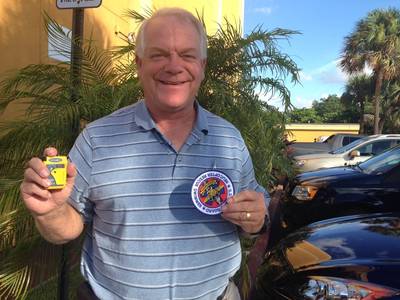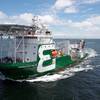Ocean Signal Beacon Saves Two in Atlantic Ocean Rescue
An Ocean Signal rescueME PLB1 was key to saving the lives of two people after a dramatic rescue in the Atlantic Ocean.
Sandy Williamson and his crew, Corey, activated their Ocean Signal personal locator beacon when their 22-foot yellow catamaran started taking on water about 20 nautical miles off the Miami coast.
The U.S. Coast Guard 7th District command centre in Miami received the emergency alert just after 11 a.m. on Sunday morning (October 27, 2013) and immediately launched an MH-65 Dolphin helicopter to the area.
Accurate registration of the PLB allowed the coast guard to promptly identify the nature of the vessel in distress and that there were two people on board.
When the aircrew arrived on the scene, the Coast Guardsmen spotted both people in the water using a life jacket and seat cushion for flotation and hoisted them into the helicopter. The pair was then flown to Air Station Miami, where, although shaken and wet, they declined medical treatment and reported no injuries.
The boaters, whose vessel completely sank, had equipped their catamaran with all the safety equipment per USCG regulations, plus the rescueME PLB1 which includes a 66-channel GPS as well as transmitting a 121.5MHz homing beacon. They also carried cell phones, but they were out of range.
They had left Miami on Sunday morning on a fast run between Miami and Bimini Island.
Mr. Williamson said, “We were 18.6 nautical miles from shore when I saw that we were taking on water fast and would need rescue. I told Corey to turn on the Ocean Signal rescueME PLB as the vessel was sinking fast. We were also able to grab life jackets, a flotation cushion, two fenders and later in the water I stuffed into a duffle bag a cell phone and the Ocean Signal rescueME PLB.
“I had many thoughts flying through my head during the emergency - primary was making sure my younger crew, Corey, stayed alive. My thoughts then went to my wife Debbie, four kids and seven grandkids.
“We were later told the PLB was properly positioned and initiated at 11 a.m. when we were floating in the ocean with 2,300 feet of dark water below us. USCG informed us later that they had received the location and registered information by 11:03 a.m. USCG quickly determined that the signal was valid by calling my brother, and initiated the rescue operation by launching a helicopter from Miami.”
It also emerged later that when the rescue helicopter arrived on the scene, it passed over them twice in a crossing pattern at about 1000 ft. – a routine maneuver to scan and find the intersection of maximum signal strength of the 121.5 MHz homing frequency.
Alan Wrigley, Managing Director of Ocean Signal, said, “The U.S. Coast Guard and many rescue authorities around the world recommend all boaters to carry an emergency beacon such as an EPIRB or PLB when offshore and this rescue proves just how critical it can be to carry these devices.
“EPIRBs and PLBs save valuable time during maritime emergencies by transmitting electronic distress signals and GPS coordinates. When EPIRBs and PLBs are properly registered, they also provide first responders with owners’ contact information and vessel descriptions, which is vital information during search and rescue cases.
“PLBs, as they continue to get smaller and with longer life batteries, are being carried by a growing number of safety conscious mariners, often attached directly to their safety gear. They are easily packed in a pocket or jacket, or attached to clothing.
“The ability of these two people to quickly activate their PLB meant that there was a happy ending to a potentially lethal incident.”
oceansignal.com











